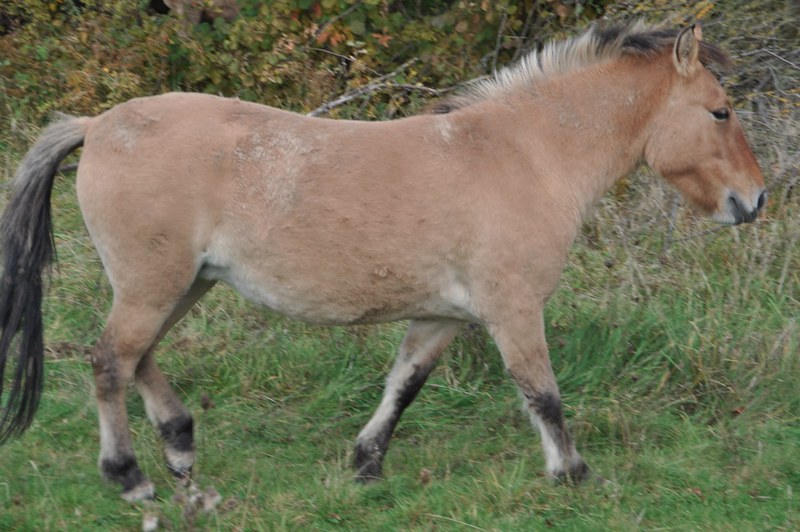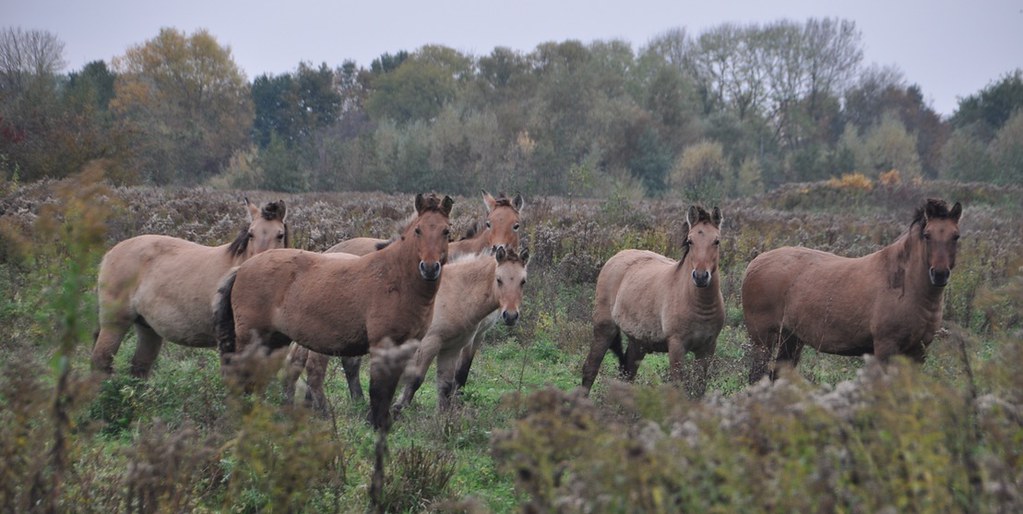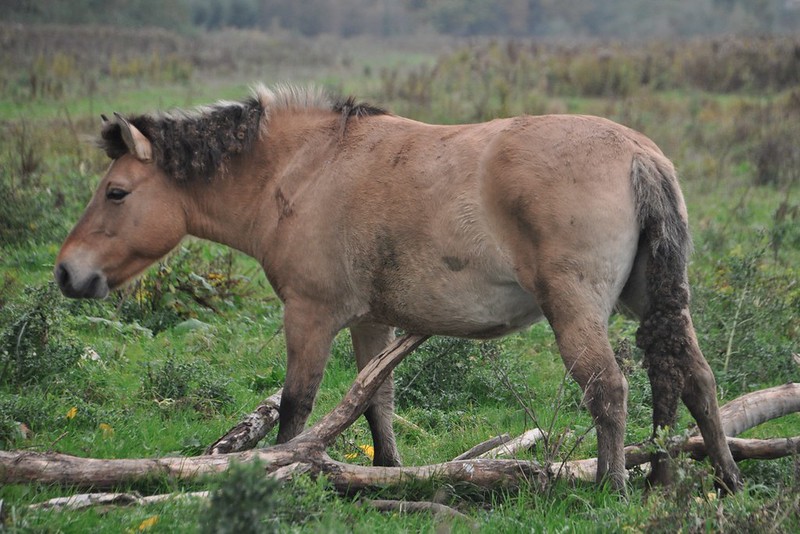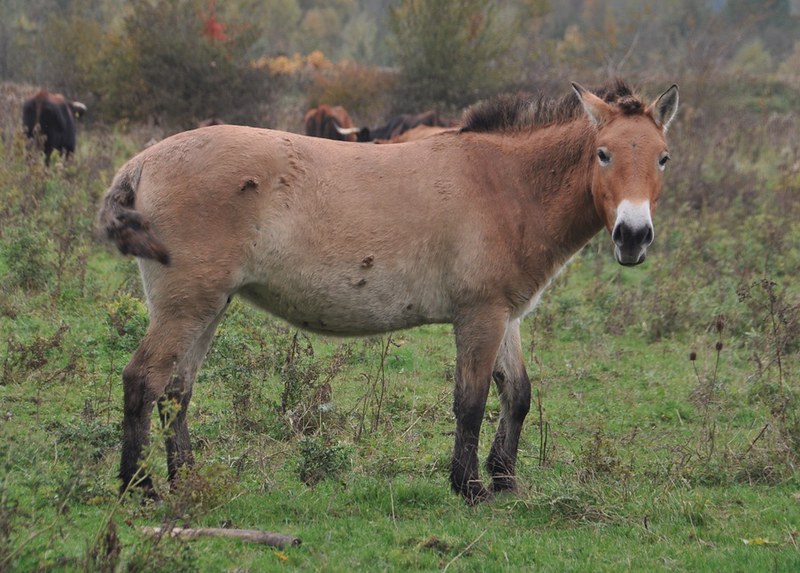Since 1996,
the crossbreeding in the Lippeaue reserve, North-Rhine Westphalia, produced
hundreds of Taurus cattle. The roughly 100 individuals from 2013 and 2015 I
presented on this blog so far are not representative for this quantity and gene pool, of course. There are plenty of now-dead or removed individuals
that may be interesting for a number of reasons; either they look good and left
a strong mark in the population, or, the contrary, they turned out to look
unsatisfying or even “weird”, revealing what is present in the gene pool beside
the good individuals. Or, they may be interesting just because of their
ancestry or the breed combination they represent. In any case, they show the
variation that is present in the population. To avoid confusion: Hellinghauser
Mersch, Klostermersch-Nord, Klostermersch-Süd and Disselmersch are all
sub-herds within the Lippeaue reserve.
I was
provided an extensive, qualitative photo archive documenting the Taurus
population over more than ten years by Matthias Scharf from the ABU that was a
great source for my research on past Lippeaue cattle, additionally to the stock
lists. Using those, I am going to present a number of those ex-inhabitants of
the reserve here in this post.
Especially
interesting to me are the bulls, because the variation spectrum of the cows can
be better seen from the current herd than that of the bulls because much fewer
bulls are kept to adulthood than cows for obvious reasons. So looking at the bulls is a bit more exciting, while many of the “older” cows still look
somewhat familiar.
Mind that I
do not know the subsequent fate of each individual I am presenting here. Not
all of these were necessarily slaughtered; the good ones tend to be sold alive
to other breeding sites where some of them could still be mooing around. But
unless I know better, I am going to write in past tense of the single
individuals.
Once again
you see that the Lippeaue herd is the most familiar and easiest accessible to
me. I’d love to do the same work with the Tauros herd in the Netherlands,
especially because no herd book was mentioned yet, but I work with the
possibilities that I have.
All of the photos were kindly provided by Matthias Scharf, so please do not replicate without permission.
Luca
This bull
should be well-known to frequent readers of the blog by now. Luca was born in
April 2001 and was the son of a Heck bull and Chianina cow. It was used as a
breeding bull in the Hellinghauser Mersch as the successor of Mator, the Dutch
Heck bull, until its death in 2011. So far, he was the only half Chianina bull
that has been used as a breeding bull in the Lippeaue. Maybe his overall
impression was not that overwhelming considering his diluted coat, compact head
and other traits, but Luca was a large buddy, and in contrast to most of the
other half Chianina bulls his horns were not tiny but medium sized and had an
acceptable curvature (just like those of his fullblood sister Ludovica). He
produced a lot of good offspring, the beautiful bull Lamarck and many others
among them.
As many of
you know, I was kindly sent his skull, which is hanging on my wall now – you
find an analysis of his skull and that of the bull Latino in this post.
Lucio
Lucio was
born in February 1998 and was one of the first, if not the first, Sayaguesa x
Heck crossbreeds. They were never completely sure if he was a indeed crossbreed
or a pure bull instead because he was born directly nine months after DonaUrraca’s arrival in the reserve. But it is considered most likely that their
Heck bull Nestor was the father, and I definitely see Heck influence in Lucio;
the trunk and the shortened face for instance. This bull had strongly
inwards-curving horns – a trait that most descendants of Dona Urraca have. His
dorsal line was well-curved as well, the hump being a legacy of its Sayaguesa ancestry.
He was a really large bull, somewhere between 160-165 cm tall at the withers.
Luca, I was told, might have been the same size. When aging, his body grew
rather hefty, revealing his Heck influence. He had been used as a breeding bull
at Klostermersch-Süd until 2006 (unless I am wrong) and left lots of offspring.
Lombriz
Lombriz was
a son of Luca and the Sayaguesa cow Sinnombre, and was born at Hellinghauser Mersch.
He had been used as a breeding bull at Klostermersch-Süd from 2007 to 2010
until he died when he accidently broke into the ice during winter in his fifth
year of life. Churro, a full-blood Sayaguesa, was his successor as breeding
bull at Klostermersch-Süd. Lombriz was larger than his half-blood brother
Lamarck, but his body shape was not quite as firm, had a colour saddle in its
summer coat and his horns didn’t have the good curvature that those of his
brother have – but they were larger, on the other hand (especially considering
that he died young and they would still have grown noticeably). Lombriz was one
of the more cautious/nervous ones, but not aggressive.
Luxus
Luxus has
been used as a breeding bull at Disselmersch for about two years. He was the
son of Lucio and Locusta, so he is a “true F2” Sayaguesa x Heck. His colour was
accurate, body shape and proportions also looked good as far as I can tell –
his head, however, was slightly short-snouted and the horns were small and
weakly curved. I don’t know about his size.
Lajos
This bull
did not live long in the Lippeaue (two years) and didn’t leave any descendants,
but I mention him because his ancestry is interesting: he resembles Luca a lot,
so I initially thought he was a half-Chianina. But in fact he is the son of
Luca and Lucona, therefore he is (Heck x Chianina) x (Heck x Lidia).
Lakritz
Lakritz was
the son of Lucio and the well-horned Neandertal cow Norda, consequently 75%
Heck and 25% Sayaguesa. He was used as a breeding bull at Disselmersch from
2007 to 2010, where he was followed by Larwin. He has been slaughtered. Being
three quarters Heck, he had a comparably heavy body and a short face, and the
horn curvature was too weak (coincidently he resembled Larwin a lot, although
both bulls were not related). But I saw and photographed his skull in 2013, and
I can tell you it made a quite big impression on me, his horn span must have
been about 100 cm or more.
Lacedo

I once
wondered where all the half-Chianina bulls go – now I know, mainly to the
butcher or get sold, mainly because of their colour. They are usually rather
diluted, some of them even almost white (as you might know from my report on
my recent trip to the Lippeaue, I’d opt for keeping a half Chianina bull if his
body shape and size are considerably better than those of the other bulls as
long as its horns aren’t too undesirable). One of those that didn’t look that
bad in my photo-based opinion was Lacedo, son of Lux (three quarter Heck, one
quarter Sayaguesa) and the Chianina Emma. His colour has the typical (probably)
Agouti-dilution where there is almost
no pheomelanin in the coat except for the forelocks and there is a saddle (that
might be there without dilutions as well), the typical colour scheme of
Podolian cattle. The body shape and proportions didn’t look that bad and his
snout looked a bit elongated, but at this young age it is impossible to judge,
it might have became the complete opposite as well.
Lurchi
This bull
was the son of Luca and Besucona, therefore half Lidia. He was about two years
old when he left the herd. I wonder what its horns would have looked like fully
grown, but perhaps not that intensely curved. On the photos, it seems like its
trunk would have become slightly longish (though firm and not that heavy), like
in many Lidia-influenced bulls. As you see, its colour was slightly diluted.
Lüster
Lüster
looked quite good, he was three quarters Sayaguesa (mother Morena) and one
quarter Heck. Pablo, half-Heck half Sayaguesa, was his father. He stayed at
Klostermersch-Nord until 2011 and left a number of descendants.
Lux
This bull
was similar in looks, although not related – father being Lucio, mother Norda,
he was three quarters Heck and one quarter Sayaguesa. He left a number of
descendants at Klostermersch-Nord and stayed in the herd at least until 2005.
84 030
One of the
“not so beautiful ones”, but interesting because of its ancestry. He was the
son of Lombriz and Ludovica, and the Chianina dilutions obviously kicked in –
he resembles his grandfather/-uncle Luca a lot, also regarding body and head.
Lem
Now this
bull has an interesting ancestry and good looks at the same time. It is the son
of Lucio and Leila, thus the product of a mating of a “true F1” and “true F2”
of the same combination (Heck x Sayaguesa). So there is the chance that he was
a bit more stable than bulls of more random combinations. Unfortunately,
however, I wasn’t able to detect descendants of Lem in the herd. I hope that he
was sold alive or even as a breeding bull to another location.
The Lidia
cows
 |
| Aguaclara |
 |
| Barbasombra |
 |
| Besucona |
Three Lidia
cows have been used in the Lippeaue. Two of them, Besucona and Aguaclara, were
wild-type coloured, while one, Barbasombra, was ED-black. Since all
of her offspring was completely black, it’s safe to assume that she was ED//ED.
One of her female offspring was Lieschen, with Luca as the father. Another one
is Larus, male, whose father is the Dutch Heck bull Mator. They are E+//ED, but phenotypically black because the latter is dominant. You can see the
descendants of the other Lidia cows in this post. Aguaclara was slaughtered,
the other two Lidia were sold.
 |
| Larus, son of Barbasombra and Mator |
 |
| Lieschen, daughter of Barbasombra and Luca |
 |
Luca with Barbasombra and Aguaclara. Notice the size difference between the Lidia cows and
the half Chianina bull. |
Luapula and
Lania
 |
| Lucyna |
 |
| Luapula |
 |
| Lania |
Luapula and
Lania are mother and daughter. Luapula was a daughter of Lucio and Lucyna, and
has a surprisingly good colour considering that her mother was an almost white
half Chianina (father Mator; in Dutch Heck cattle, Podolian-type dilutions are
more common than in Neandertal Hecks, so maybe Mator passed on such an allele,
producing a homozygous white colour). Lania the daughter of Luapula and Lucio.
Both those cows are remarkable for their small horns.
00674, a
daughter of Lakritz (75% Heck, 25% Sayaguesa) and Ladilla (50% Sayaguesa, 50%
Heck), also happened to have small horns. This, together with the good colour
of Luapula despite her mother, shows how much genetics work per coincidence.
 |
| 00674 |
Lutra
Half Mator
and half Lusitana (Sayaguesa x Heck). Despite being three quarters Heck, she
had a good body shape, at least at young age. I like her beautiful
chestnut-brown colour that reminds me of a Maronesa cow.
Leier
Leier is
the daughter of Luca and Lukulla (Heck x Sayaguesa), and looked quite good,
although her colour could have been a bit more intense. I was told that she was
a nasty one, and she was slaugthered.
Loxia
Loxia was a
fullblood sister of Lamarck (Luca x Dona Urraca [Sayaguesa]). She looked quite
good. Together with her father, she produced a number of offspring. And she
also produced at least one “true F2” (42 621) with her brother, that, unfortunately,
happened to look disappointing (at least in my opinion) – genetics work by
coincidence, as I said above.
 |
| 42 621, daughter of Lamarck and Loxia |
Laguna
Laguna was
a daughter of Luca and Lamarck’s full-blood sister Lametta. This cow is another
one of those which have this kind of dilution that causes a cream-coloured coat
with a dark mouth and grey-pink nose. I suspect this variant gets passed on by
Chianina, although it rarely also appears in pure Hecks too. She left no track
in the herd as far as I can see.
Latina
This cow is
a daughter of Leonardo (the Heck x Chianina bull that went to Denmark) and
Ladilla, a Sayaguesa x Heck. So she is of the same breed combination as Lale,
but there you see how the same combinations can work out differently: Latina
has the desired colour but small, weakly curved horns, while Lale has a diluted
colour but with larger and better curved horns. Leier was of the same
combination too. It seems that Latina left no track in the population.
84 022
Some of you
might already know this cow from the VFA’s sale page. She was a daughter of
Latino and quarter-Sayaguesa cow Lea. She was short-legged, black and her horns
were meagre, so she was selected out; however, she seemingly produced one calf,
but I don’t know the fate of that one.
Lulu II
A fullblood
sister of Lombriz. She looked quite good, except for her horns.
Lotta
Lotta was
the daughter of Lucio and Elosia, therefore half-Chianina. Surprisingly, her
colour was not diluted at all. Unfortunately, she happened to have bad horns.
The Heck
cows


The ABU
used a number of large-horned Neandertal Heck cows; Norda, for example, had
large and well-shaped horns. Lina had more Heck-typical horns (and a typical
Heck body too), but they were comparably large. Loreley had even larger ones
(despite being half Mator). But interestingly, it seems that there have never
been Taurus crossings showing the maximum horn size that Heck cattle brought
into the population (as far as I know), but there are a number, as you have
seen, that show the minimum horn size (i.e. Chianina horn size). I do not know
why this is the case – all of them live in the same environment, so that is not
a factor. Maybe the alleles that cause the really large horns are more
recessive than those that cause small and all the intermediate shapes and
therefore the probability for them being expressed is way lower, but I don’t
know. EDIT: The explanation is quite simple. It seems that the contribution of the largest-horned Heck cow to the whole population was only minor, in fact there are no living descendants of Norda in the herd by now.






























































